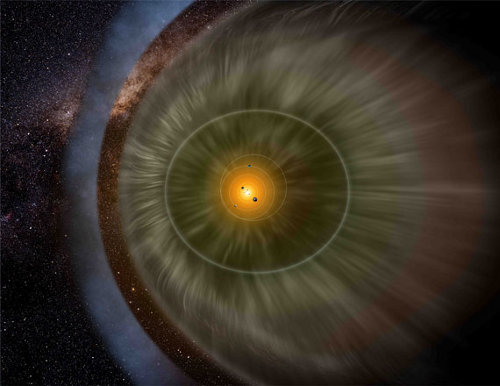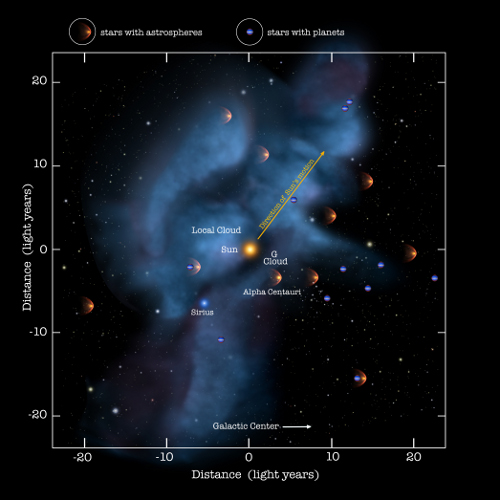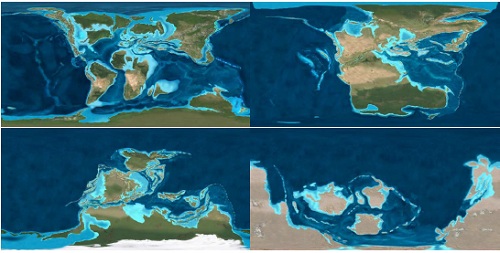Centauri Dreams
Imagining and Planning Interstellar Exploration
‘Super-Earth’ in a Triple Star System
GJ 667C is an M-class dwarf, part of a triple star system some 22 light years from Earth. Hearing rumors that a ‘super-Earth’ — and one in the habitable zone to boot — has been detected around a nearby triple star system might cause the pulse to quicken, but this is not Alpha Centauri, about which we continue to await news from the three teams studying the prospect of planets there. Nonetheless, GJ 667C is fascinating in its own right, the M-dwarf being accompanied by a pair of orange K-class stars much lower in metal content than the Sun. The super-Earth that orbits the M-dwarf raises questions about theories of planet formation.
Thus Steven Vogt (UC Santa Cruz), who puts the find into context, noting that heavy elements like iron, carbon and silicon are considered the building blocks of terrestrial planets:
“This was expected to be a rather unlikely star to host planets. Yet there they are, around a very nearby, metal-poor example of the most common type of star in our galaxy. The detection of this planet, this nearby and this soon, implies that our galaxy must be teeming with billions of potentially habitable rocky planets.”

Image: An artist’s impression of a super-Earth planet. Credit: ESO/M. Kornmesser.
Nearby is right, and assuming we do eventually develop the technologies to send probes to distances of tens of light years out, this super-Earth would surely gain a place high on the target list. The reference to the most common stars in the galaxy is drawn from estimates that 75 to 80 percent of all stars in the Milky Way may be M-dwarfs, although the relative percentages will surely be adjusted as we get a better handle on the distribution of brown dwarfs. Vogt refers to multiple planets because in addition to the super-Earth orbiting GJ 667C, there appears to be evidence for additional planets, perhaps as many as three, orbiting the same star.
Building on earlier work on a different super-Earth in the same system (GJ 667Cb), too close to the star to allow liquid water to exist on its surface, the research team found the signature of the new planet GJ 667Cc, with an orbital period of 28.15 days and a minimum mass of 4.5 times that of Earth. Guillem Anglada-Escudé (Carnegie Institution for Science) calls the latter world “…the new best candidate to support liquid water and, perhaps, life as we know it,” though we have to add the usual caveats about flare activity on M-dwarfs and their potential for disrupting life.
Those other worlds in the same system? A possible gas giant and yet another super-Earth are candidates, but neither has been confirmed. Meanwhile, GJ 667Cc is thought to absorb about the same amount of energy from its star that the Earth draws in from the Sun, leading to the possibility of Earth-like temperatures and, if conditions are right, the potential for liquid water. As with all such results, further information about the planet and its atmosphere are needed before we can run too wild with such speculation, but GJ 667Cc clearly deserves a much closer look.
The paper is Anglada-Escudé et al., “A planetary system around the nearby M dwarf GJ 667C with at least one super-Earth in its habitable zone,” accepted at the Astrophysical Journal Letters (preprint).

IBEX: The Heliosphere in Motion
The beauty of having spacecraft that far outlive their expected lives is that they can corroborate and supplement data coming in from much newer missions. That’s the case with our Voyager spacecraft as they continue their progress at system’s edge. The Voyagers will be moving outside the heliopause in not so many years, and when they do, they will tell us much about the behavior of charged particles in the interstellar medium. This will bulk up incoming results from IBEX, the Interstellar Boundary Explorer spacecraft, as it studies the neutral particles that routinely penetrate the heliosphere. Our knowledge of true interstellar space is growing.
It’s at the heliopause that we see the boundary between the area defined by the solar wind flowing outward from the Sun and the interstellar medium that surrounds it. Racing outward at an average of 440 kilometers per second, the solar wind is pushing into a region of dust and ionized gas, inflating the bubble we know as the heliosphere. The entire heliosphere incorporates the Sun and all the planets. Because interstellar neutral atoms do not interact with magnetic fields, they move through the heliopause readily, while charged particles do not. Hence the utility of the Voyagers, which will now move into a region from which we’ve had no prior data return.

Image: An artist’s rendition of a portion of our heliosphere, with the solar wind streaming out past the planets and forming a boundary as it interacts with the material between the stars. Credit: Adler Planetarium/IBEX team.
IBEX is a long way from the heliopause, orbiting the Earth with an apogee of 322,000 kilometers and a perigee of 16,000 kilometers, but its instruments are designed to map the distant interactions between the solar wind and ionized interstellar material, creating a map of the boundary. In addition, its low-energy energetic neutral atom camera is measuring inflowing interstellar neutral particles of the kind first measured by the Ulysses spacecraft. The IBEX measurements, recently discussed in a set of new papers, are helping us map the distribution of elements like hydrogen, helium, neon and oxygen as they enter the heliosphere from the local interstellar medium. By contrast, Ulysses was only able to detect neutral interstellar helium.
One thing we’re learning is the shape of the heliosphere. Interstellar neutral atoms enter the heliosphere at a speed of roughly 84,000 kilometers per hour. That’s a good deal slower than what Ulysses found, and IBEX sees the neutral particles entering the heliosphere from a somewhat different direction. “With this lower speed, the external magnetic forces cause the heliosphere to become more squished and misshapen,” says David McComas (SwRI), IBEX principal investigator. “Rather than being shaped like a bullet moving through the air, the heliosphere becomes flattened, more like a beach ball being squeezed when someone sits on it.”
IBEX is also showing us that our Sun is located in a region of space where dust and gas are extremely thinly dispersed, a situation different from the relative abundances of certain elements during the period when the Sun was formed. The neon to oxygen ratio in the Sun offers a glimpse of what the abundances of those elements were in that early era. IBEX, by measuring oxygen and neon from the interstellar medium, is finding less oxygen than expected, an indication of possible changes in the medium during the Sun’s lifetime. Alternatively, it is possible that the oxygen is still present but locked up in ice grains in the local interstellar material. McComas again:
“Our solar system is different than the space right outside it, suggesting two possibilities. Either the solar system evolved in a separate, more oxygen-rich part of the galaxy than where we currently reside, or a great deal of critical, life-giving oxygen lies trapped in interstellar dust grains or ices, unable to move freely throughout space.”
Interstellar space is far from empty, and IBEX is showing us what our early interstellar precursor missions may encounter. The Sun is evidently close to the boundary of a local cloud of gas and dust, one of many such clouds in our local galactic neighborhood. Ulysses results had indicated the Sun was placed between the ‘Local Cloud’ and the ‘G-Cloud,’ close to the boundary of the Local Cloud. The new IBEX work challenges this assumption, finding that the heliosphere is still fully within the Local Cloud. But we’re moving quickly (within a few thousand years at most) to leave the Local Cloud and move into what McComas calls ‘a much different galactic environment.’ IBEX and the Voyagers, then, are filling in our knowledge not only of the heliopause but the regions that surround our system as we move through the galaxy.

Image: The solar journey through space is carrying us through a cluster of very low density interstellar clouds. Right now the Sun is inside of a cloud that is so tenuous that the interstellar gas detected by IBEX is as sparse as a handful of air stretched over a column that is hundreds of light years long. These clouds are identified by their motions. Credit: NASA/Goddard/Adler/U. Chicago/Wesleyan.
Make no mistake about the importance of the heliosphere — it is an important zone of protection against dangerous cosmic radiation, and thus has implications for the evolution of life, given that varying levels of radiation create genetic mutations and possible extinctions. How the makeup of the interstellar medium affects the heliosphere is thus a major issue, and changes as we move outside the Local Cloud could affect the heliosphere in ways we don’t yet understand. We’ll also use IBEX data to inform our studies of the analogous ‘astrospheres’ surrounding other stars.
Coda: Does any of this business about moving out of a local cloud and into more open interstellar space evoke for anyone else the same pleasing memories of Poul Anderson’s Brain Wave (1954)? Just checking.
The papers on the recent IBEX findings appeared in a Special Supplements issue of the Astrophysical Journal called “Interstellar Boundary Explorer (IBEX): Direct Sampling of the Interstellar Medium,” which appeared on January 31.

Cloud Cover’s Role in Exoplanet Studies
I confess it had never occurred to me to consider cloud cover on exoplanets in quite the same light that a new study does. But two Spanish astronomers from the Astrophysical Institute of the Canary Islands (IAC) are taking a look at how clouds operate over different kinds of surfaces, in the process figuring out what our Earth would have looked like from space in different eras. It’s an interesting thought: Given the movement of Earth’s continents in the past 500 million years, what would cloud patterns have been like over land and sea as landforms changed?
The researchers chose several times to study, from 90, 230, 340 to 500 million years ago, pondering how changes in light reflected from the Sun would have operated here and, by extension, how they might operate on distant exoplanets. We’ll need to keep these things in mind when we get the capability of studying the atmospheres of terrestrial planets around other stars. And it turns out that, according to the researchers, cloud cover is anything but random. Deserts tend to stay clear of clouds, while rainforests are frequently and densely clouded over.
As described in this article in Astrobiology Magazine, Enric Pallé and Esther Sanromá worked with 23 years worth of data from the International Satellite Cloud Climatology Project to study how landforms and clouds correlate. They then plugged in differing continental distributions over time, going back to roughly the period when the atmosphere’s temperature and composition varied too greatly from our own to make adequate projections. It turns out that daily variations were scarce through much of the studied period, but 500 million years ago, the changes in light were clearly marked. The paper on this work explains the situation:
The re?ected light of the Earth at 500 Ma ago… presents much more variability in contrast to the light curves obtained for the other epochs. That is again related to the continental distribution. In this epoch, most of the continents were clustered in one hemisphere, but it also has several big islands that cause strong variability in the re?ected light. Moreover, this epoch presents a signi?cantly higher mean albedo value. That can be related to the fact that in this epoch continents were covered by deserts, thus involving a higher re?ectivity.
A light curve is about the best we’re going to get for a terrestrial exoplanet once we actually do gain the ability to study exoplanets through space-based planet-finder observatories of the future, at least in the beginning. Pallé and Sanromá’s work implies that a terrestrial world with small variations could be one with vegetation on the surface. Rocky planets with no atmosphere and planets with global cloud cover would show no variations whatsoever, but as Pallé says, “if it has an atmosphere with broken clouds, we will see it in variability.” The scattered clouds, then, might be flagging the presence of oceans and implying the existence of living ecosystems.
In the paper, Pallé and Sanromá go on to comment:
We ?nd that our model reproduces well the major features of the cloud distribution and the photometric light curve of the Earth at present. When applied to past epochs of the Earth, we ?nd that both the mean albedo value and the diurnal light curve variability remain stable as long as desert area are con?ned to the tropical regions. When this condition is not met, as during the Late Cambrian about 500 Ma ago, both the mean albedo value and the photometric variability are greatly increased. This increased variability could help in the determination of the rotational period of the planet from an astronomical distance. Due to the large compositional and chemical changes of Earth’s atmosphere, we have not attempted to reconstruct cloud cover maps for epochs prior to the Late Cambrian. However, it is likely that the conditions for this period, i.e., higher albedo values and photometric variability, hold for much of the previous epochs of the Earth, not considering possible albedo variations due to atmospheric changes coming from clouds, aerosols, and hazes.

Image: Figure 1 from the Sanromá and Pallé paper, showing global views of the Earth’s continental distribution during the Late Cretaceous (90 Ma ago, top left), the Late Triassic (230 Ma ago, top right), the Mississippian (340 Ma ago, bottom left), and the Late Cambrian (500 Ma ago, bottom right). Credit: Ron Blakey, Colorado Plateau Geosystems.
We’re obviously only beginning the study of exoplanet atmospheres, but it’s certainly worth noting that we’ve had useful results in characterizing the atmospheres of some ‘hot Jupiters,’ work which is producing various models to explain what astronomers are seeing. We’ve also studied Earth’s own light through ‘Earthshine’ (reflected off the Moon) analyzed at various wavelengths, and have examined our planet’s light curve from space. Moreover, an interesting body of work has arisen to analyze the characteristics of light as absorbed by vegetation.
It also seems obvious that when we do observe a planet similar to the Earth, it will not be at the same stage of evolution as the Earth today, making modeling of our own planet’s earlier eras a useful exercise as we piece together an observing strategy. The paper is Sanromá and Pallé, “Reconstructing the Photometric Light Curves of Earth as a Planet Along its History,” accepted by the Astrophysical Journal (preprint).

Toward a New ‘Prime Directive’
The Italian contribution to the interstellar effort has been substantial, and I’m pleased to know three of its principal practitioners: Claudio Maccone, Giancarlo Genta, and Giovanni Vulpetti. It was with great pleasure, then, that I took Roberto Flaibani up on his offer of appearing in his excellent blog Il Tredicesimo Cavaliere (The Thirteenth Knight). Roberto had translated several Centauri Dreams articles into Italian in the previous year and was now looking for comments on the ramifications of human contact with extraterrestrials as we push into interstellar space. This article on Star Trek’s Prime Directive grew out of our talks and became part of a broader discussion of related articles on Roberto’s site. I thank him for continuing to translate my work into Italian, and now offer the original essay to Centauri Dreams readers.
I should probably throw in a qualifier — I’ve always enjoyed Star Trek but am hardly a rabid fan, getting most of my science fiction not from film or TV but novels and short stories. So this is a bit of a jeu d’esprit, one that acknowledges that the show has indeed spun out provocative and often controversial scenarios.
The Prime Directive embodies a flawed but useful ethical principle that should remain in place, though not without extensive revision. To understand why we need to re-think some aspects of the Prime Directive, let’s consider the context in which it operates. Because it grew out of ‘Star Trek,’ we have to posit a universe much like that one to illuminate the regulation’s strictures. Let’s assume, then, that humans become a spacefaring civilization on not just an interplanetary but an interstellar scale. That means that through whatever means, we have acquired ways of getting to the stars in short time frames, and that an organization has emerged within which this exploration continues, an analogue to the Federation behind the directive.

Why would the Prime Directive emerge in the first place? Here it is important to remember that in the ‘Star Trek’ universe, the directive is actually a regulation that applies only to Starfleet. Indeed, the series shows us that if a citizen of the Federation has decided on his or her own volition to interfere with another civilization, Starfleet is powerless to prevent such actions. The regulation doubtless was called for because the outermost wave of human expansion would be the exploring arm embodied in Star Fleet itself. What happens after a given region of space is first charted and explored is up to individual action, but the people most likely to be involved in first contact with an alien culture are those operating under Federation regulations.
All of this seems like logical extrapolation, and it is a tribute to the ‘Star Trek’ universe that despite the number of television episodes in various configurations and movies using many of the same characters, the storyline has been kept relatively consistent. If we ever do develop a way of sending human crews to other worlds, we will ponder the question of how we interact with any intelligent species we find there. And it’s likely we’ll consider a principle something like “the right of each sentient species to live in accordance with its normal cultural evolution,” a phrase pulled from the text of the Prime Directive. What we are looking at is the development of ‘metalaw,’ a term devised by attorney Andrew Haley in 1956 to specify a system of laws that apply not just to human beings but to all relationships between intelligent species.
Evolving Metalaw and Human Culture
Why not simply resolve to treat alien cultures using the principles of the Golden Rule — treat aliens as we would wish to be treated by them? Haley went on to point out the problem with this approach in a paper called “Space Law and Metalaw – A Synoptic View,” recognizing that aliens are different from ourselves in ways we may not begin to understand. Treating them as we would like to be treated might cause them injury or even destroy them. Haley revised the Golden Rule this way: “Do unto others as they would have you do unto them.” Robert Freitas, who has written thoughtfully on the subject of metalaw, notes that this ‘Great Rule’ has its own problems: “…in practice the Great Rule would be as difficult to apply as the concepts of noninterference and physical security. If we are to ascertain the desires of the other party, we must interact with them to a certain degree – and this may cause sociocultural damage. We still are left with the problem of developing nonconflicting, serviceable metalegal rules.”
We are in the earliest stages of developing ‘metalaw’ today, but a widening sphere of human activity among the stars will eventually force us to move the concept forward. Aerospace engineer Giancarlo Genta (Politecnico di Torino) has examined these questions in his book Lonely Minds in the Universe (Copernicus, 2007), studying the entire question of whether an alien being in today’s world could be considered a ‘person.’ An interesting legal issue would arise if we suddenly found ourselves face to face with a being from another world. We may believe in extending equal rights to all humans no matter their origin, but an extraterrestrial who walked out of a spaceship after landing on Earth would not necessarily be recognized by law as a ‘person.’ Would this creature be considered an animal? If so, would an alien animal have rights under existing law?
The Prime Directive can be assumed to have grown out of discussions exactly like these, and it hinges on the extension of the idea of personhood to alien intelligences. In his paper “Metalaw and Interstellar Relations” (cited above) Robert Freitas sees two routes to personhood:
- The use of a clear morality; i.e., the ability of the beings in question to make moral or ethical judgments, even if those judgments do not necessarily coincide with our own
- The presence of self-awareness, of being separate from one’s surroundings.
The presence of either morality or self-awareness is seen as the key to personhood. Here we seem to be splitting hairs in legalistic fashion, but the issue is important because human law revolves around the concept of the person. Metalaw, in other words, leads us invariably to the thinking that leads to the Prime Directive, which we can now quote in more extended form:
As the right of each sentient species to live in accordance with its normal cultural evolution is considered sacred, no Star Fleet personnel may interfere with the normal and healthy development of alien life and culture. Such interference includes introducing superior knowledge, strength, or technology to a world whose society is incapable of handling such advantages wisely. Star Fleet personnel may not violate this Prime Directive, even to save their lives and/or their ship, unless they are acting to right an earlier violation or an accidental contamination of said culture. This directive takes precedence over any and all other considerations, and carries with it the highest moral obligation.
A Silence Between Civilizations?
We now find ourselves in a quandary, for the Prime Directive must be interpreted, just as any body of law or regulation must be understood and acted upon by those affected by it. If we read the text closely, we have no choice but to conclude that the only contact possible between two alien civilizations would happen when the two civilizations are at precisely the same point of development, or as Giancarlo Genta phrases it, the same cultural level. A right is assumed in the Prime Directive for each species to proceed through a ‘normal’ cultural evolution, one which cannot be interfered with by introducing superior knowledge or technologies.
A civilization less advanced than our own in terms of technology, then, would be one we could not contact directly. A civilization more advanced than our own would, if acting under the principles of a similar Prime Directive, be unable to contact us. If the Prime Directive were a universal principle, no species would be able to contact another unless it encountered one so similar to itself that the contact would be considered harmless. Given the wide variation in stellar ages around us in the Milky Way, it seems spectacularly unlikely that we would find a species this similar to ourselves, and all studies of alien cultures would have to be conducted with maximum secrecy to avoid contaminating the alien civilization in question.

This seems an unwise outcome on various levels, but there’s more. What do we mean by the ‘same cultural level?’ Culture is what we recognize around us in the form of the familiar accouterments of society and the technologies we use to provide and service them. But the very idea of an alien culture presupposes a development unlike our own. We could not assume that a culture that seemed similar to our own at the level it was at in the time of ancient Greece would necessarily undergo a similar period of imperial expansion on its planet, a gradual awakening to other cultures across its oceans, a period when learning was lost and an eventual renaissance. Nor could we assume that the beings who live within this culture operate with the same set of principles that we do, or that they would develop technologies comparable to our own.
Note the other flaw in the Prime Directive statement above. We are told that interference consists of introducing superior knowledge, strength, or technology to a world ‘whose society is incapable of handling such advantages wisely.’ The statement implies that if a society is deemed capable of handling these advantages with wisdom, the strictures of the Prime Directive to not apply. But who is to make the decision as to the wisdom of an alien civilization, and how accurate can such an assessment be given the short periods involved in a first contact scenario? And what does the Prime Directive mean by not interfering with the ‘normal and healthy development’ of another culture? To understand what is normal and healthy for an alien civilization may be an impossible accomplishment, and certainly not one we could achieve without extensive study. No, the Prime Directive binds us too severely and limits any contact.
More Supple Rules of Contact
Where to go from here? We need a revised Prime Directive based on an evolving metalaw, one that recognizes that each encounter with an extraterrestrial civilization is going to be different from any other. Genta cites the eleven rules of metalaw compiled by the Austrian lawyer `Ernst Fasan, drawing on the earlier work of Andrew Haley. These are drawn from Fasan’s book Relations with Alien Intelligences: The Scientific Basis of Metalaw (1970), and contain the seeds of a future Prime Directive that should prove more flexible:
1. No partner of metalaw may demand an impossibility.
2. No rules of metalaw must be complied with when compliance would result in the practical suicide of the obliged race.
3. All intelligent races of the Universe have in principle equal rights and values.
4. Every partner of metalaw has the right to self-determination.
5. Any act that causes harm to another race must be avoided.
6. Every race is entitled to its own living space.
7. Every race has the right to defend itself against any harmful act performed by another race.
8. The principle of preserving one race has priority over the development of another race.
9. In case of damage, the damager must restore the integrity of the damaged party.
10. Metalegal agreements and treaties must be kept.
11. To help the other race by one’s own activity is not a legal but a basic ethical principle.
Here we have a set of guiding principles that do not exclude contact between civilizations of different levels of development and complexity. Instead, Fasan’s ideas form a framework that a future commander of an interstellar mission could consult to make decisions about the level of contact appropriate for that situation. Fasan cannot answer all our questions — in particular, we have the conundrum that the ethical concepts embedded here may be profoundly anthropocentric, and we certainly have no idea whether other intelligent races would agree or abide by such ideas. But the scant work that has thus far been done on metalaw points us to the need for an enhanced, more carefully thought-out Prime Directive, one that does not entangle an exploring party far from home with legalities that could compromise a beneficial first contact.
Here it is time to quote Genta directly:
Such rules are without doubt a good starting point on which to build the laws and ethics or relationships between species, but they have been elaborated by one of the sides only — and it could not be otherwise, since it is not even certain that the other sides exist. Moreover, if it is true that the other species with which we could come in contact are much more ancient than ourselves, it is likely that they already faced this problem and established rules for relationships among species.
The reality is that as we expand to nearby stars and beyond, we will learn from our early contacts with other civilizations — if indeed they exist — and shape our metalaw flexibly from each of these encounters. Metalaw cannot be other than an evolving set of principles, incapable of setting down as a Prime Directive that does not grow with our knowledge over time. The Prime Directive offers us a wonderful way to consider the issues. But we need to be aware that it is a template only, and that what we find among the stars will help us shape its future direction. We must also be thinking about these matters long before we actually get to the stars. As Robert Freitas reminds us, “When intelligent extraterrestrial life is discovered, mankind must be prepared, for in all of human history there will be but one first contact.”
References
Fasan, E, Relations with Alien Intelligences: The Scientific Basis of Metalaw, Berlin Verlag, Berlin, 1970. See also his paper “Discovery of ETI: Terrestrial and Extraterrestrial Legal Implications,” Acta Astronautica 21 (2) (1990), pp. 131-135.
Freitas, R, “Metalaw and Interstellar Relations,” Mercury 6 (March-April, 1977), pp. 15-17 (available online)
Genta, G. Lonely Minds in the Universe. New York: Copernicus, 2007.
Haley, A “Space law and Metalaw – A Synoptic View,” Harvard Law Record 23 (November 8, 1956).

New Multiple Planet Systems Verified
Confirming Kepler’s planet candidates is a crucial part of the process, because no matter how tantalizing a candidate appears to be, its existence needs to be verified. We have more than 60 confirmed Kepler planets and over 2300 candidates, many of which will eventually get confirmed, but it’s interesting to see that the mission’s latest announcements relate to multiple planet systems and how their presence can itself speed up the verification process.
In today’s focus are the eleven new planetary systems just announced, 26 confirmed planets in all, which actually triples the number of stars known to have more than one transiting planet. One of the systems, Kepler-33, has been demonstrated to have five planets. We also have five systems (Kepler-25, Kepler-27, Kepler-30, Kepler-31 and Kepler-33) showing a 1:2 orbital resonance — the outer planet orbits the star once for every two orbits of the inner planet — and four systems with a 2:3 resonance, with the outer planet orbiting twice for every three times the inner planet completes its orbit.
Image (click to enlarge): The artist’s rendering depicts the multiple planet systems discovered by NASA’s Kepler mission. Out of hundreds of candidate planetary systems, scientists had previously verified six systems with multiple transiting planets (denoted here in red). Now, Kepler observations have verified planets (shown here in green) in 11 new planetary systems. Many of these systems contain additional planet candidates that are yet to be verified (shown here in dark purple). For reference, the eight planets of the solar system are shown in blue. Credit: NASA Ames/Jason Steffen, Fermilab Center for Particle Astrophysics
Usefully for verification purposes, these are systems in which the planets are relatively close to their host stars, with orbital periods between six and 143 days, the tight configuration creating a clear Transit Timing Variation (TTV) signature as the planets tug and pull on each other. TTV makes verification much simpler and eases the need for backup observations from ground-based telescopes. We’ve looked at Transit Timing before in its application for possible detection of exomoons, but it’s also useful for analyzing planetary systems around fainter, more distant stars.
Eric Ford (University of Florida) and colleagues discuss the utility of TTVs in the paper on their work on Kepler-23 and Kepler-24:
For systems with MTPCs [multiple transiting planet candidates], correlated TTVs provide strong evidence that both transiting objects are in the same system. Dynamical stability provides an upper limit on the masses of the transiting bodies. For closely-spaced pairs, the mass upper limit is often in the planetary regime, allowing planets to be confirmed by the combination of correlated TTVs and the constraint of dynamical stability.
And Jack Lissauer (NASA Ames) and team discuss the validity of Kepler’s multiple planet candidates in a separate paper. The italics are mine:
Roughly one-third of Kepler’s planet candidates announced by Borucki et al. (2011) are associated with targets that have more than one candidate planet. False positives (FPs) plague ground-based transit searches, but the exquisite quality of Kepler photometry, combined with the ability to measure small deviations in center of light during transits (Jenkins et al. 2010; Batalha et al. 2010), have been used to cleanse the sample prior to presentation in Borucki et al. (2011). Accounting for candidates on each one’s individual merit, Morton & Johnson (2011) estimated the fidelity of Kepler’s planet candidates (fraction of the candidates expected to be actual planets) to be above 90%. Yet the fidelity of multiple planet candidates is likely to be higher than that for singles (Latham et al. 2011; Lissauer et al. 2011a). We show herein that the vast majority of Kepler’s multiple planet candidates are true multiple planet systems.
Find multiple planets in the same system, then, and the odds on their being verified are excellent, what Lissauer calls ‘validation by multiplicity,’ based on our knowledge of the properties of the host star and examination of planetary transits that show similar signatures around the same star. Thus the gravitational dance of multiple planets leads to faster verifications as the orbital period of each planet changes through the slightest of variations in its transit timing. Now we have yet another crop of exoplanets, fifteen of them between Earth and Neptune in size. But whether these smaller planets are rocky worlds or gaseous ‘Neptunes’ will have to be the subject of further study.
The papers are Lissauer et al., “Almost All of Kepler’s Multiple Planet Candidates are Planets” (preprint); Ford et al., “Transit Timing Observations from Kepler: II. Confirmation of Two Multiplanet Systems via a Non-parametric Correlation Analysis,” accepted at the Astrophysical Journal (preprint); Steffen et al., “Transit Timing Observations from Kepler: III. Confirmation of 4 Multiple Planet Systems by a Fourier-Domain Study of Anti-correlated Transit Timing Variations,” accepted by MNRAS (preprint); and Febrycky et al., “Transit Timing Observations from Kepler: IV. Confirmation of 4 Multiple Planet Systems by Simple Physical Models,” in press at the Astrophysical Journal (preprint).

Project Bifrost: Return to Nuclear Rocketry
Back in the days when I was studying Old Icelandic (this was a long time ago, well before Centauri Dreams), I took a bus out of Reykjavik for the short journey to Þingvellir, where the Icelandic parliament was established in the 10th Century. It was an unusually sunny day but that afternoon the storms rolled in, and just before sunset I remember looking out from the small hotel where I was staying to a rainbow that had formed over the lava-ridden landscape. It inevitably brought to mind Bifröst, the multi-colored bridge that in Norse mythology connected our world with Asgard, where the gods lived. The idea may have been inspired by the Milky Way.
In the world of rocketry, a new Bifröst has emerged, one designed to link the nuclear rocket technologies that were brought to a high level of development in the NERVA program with our present-day propulsion needs. For despite a serious interest that resulted in a total of $1.4 billion in research and the testing of a nuclear engine, NERVA (Nuclear Engine for Rocket Vehicle Application) was cancelled at the end of 1972. The work that went into the concept dated back to studies at Los Alamos starting in 1952 and extended through the 1950s with Project Rover.

The design in question is a nuclear thermal rocket (NTR), which uses nuclear fission instead of chemical combustion to heat a hydrogen propellant, making for both high exhaust velocity and high thrust. As Tabitha Smith notes in an article on Project Bifrost, Rover/NERVA technologies were once regarded as a natural follow-on to the Apollo missions, cited by President Kennedy in the same speech in which he challenged the United States to land a man on the Moon and bring him home by the end of the decade. In fact, some believed NERVA could get us to Mars before 1980. Its advantages were clear: If used as an upper stage for the Saturn rocket (Saturn S-N), the nuclear technology would have allowed payloads as large as 340,000 pounds to reach low Earth orbit, up from the 280,000 pounds that the all-chemical Saturn V could achieve.
Image: NERVA nuclear rocket under test. (Smithsonian Institution Photo No. 75-13750).
Anti-nuclear sentiment was part of NERVA’s downfall, but so too was the post-Apollo retreat from space and the expenditures it involved. It was probably NERVA’s link with a possible Mars mission that caused many politicians to put on the brakes, unwilling to see NASA commit itself to an even more intractable and expensive goal than the original Moon missions. Whatever the case, nuclear propulsion has been in the doldrums ever since, which is why Project Bifrost has sprung into existence. The abovementioned Tabitha Smith is research lead for Bifrost as well as being chief strategic officer for Washington DC-based General Propulsion Sciences. Along with colleague Brad Appel at GPS, Smith initiated the project in collaboration with Icarus Interstellar.
Appel sees nuclear technologies as a major step toward next-generation space travel, drivers for the manned mission to Mars we have been anticipating since the dawn of the space era and the concept studies of Wernher von Braun. Smith quotes Appel on the advantages of a nuclear thermal rocket:
“…imagine you are planning a road trip from New York to Los Angeles and back. Except, there are no gas stations along the way — you need to pack all of the fuel along with you. Using a chemical rocket to send humans to Mars would be like making the road trip in a cement truck. You might barely make it, but it would be one enormous, inefficient, and expensive voyage. Using an NTR, however, would be more akin to taking a Prius. It’ll make it there comfortably, and it can go a lot further too.”
Project Bifrost makes sense, given that while commercial space companies like SpaceX are moving to become cargo carriers to LEO, there is little work within the US government to further develop concepts like NERVA. Smith was recently in Moscow to pursue the idea of international collaboration in nuclear thermal rocketry, invited there as part of President Dmitry Medvedev’s initiatives to spur entrepreneurship and international collaborations in Russia. Whether or not the journey bears fruit, General Propulsion Sciences and Icarus Interstellar intend to bring NTR technologies up to date. A nuclear alternative to chemical methods would spur renewed interest in a Mars mission once thought to be all but inevitable before the end of the 20th Century.



